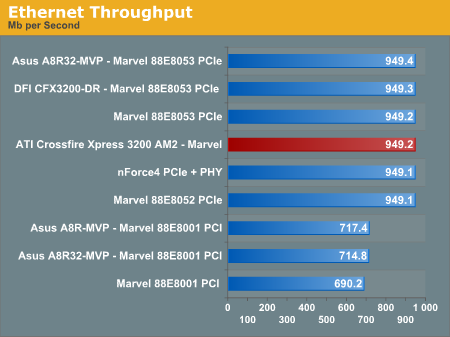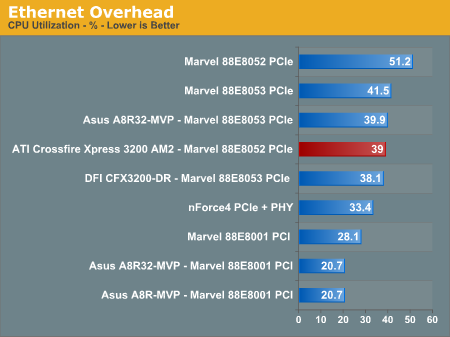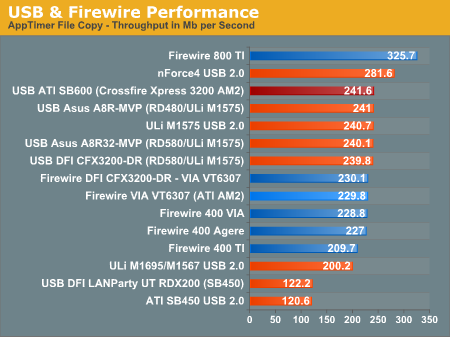CrossFire Xpress 3200: RD580 for AM2
by Wesley Fink on June 1, 2006 12:05 AM EST- Posted in
- Motherboards
Network
The Windows 2000 Driver Development Kit (DDK) includes a useful LAN testing utility called NTttcp. We used the NTttcp tool to test Ethernet throughput and the CPU utilization of the various Ethernet Controllers used on the AMD motherboards.
We set up one machine as the server; in this case, an Intel box with an Intel CSA Gigabit LAN connection. Intel CSA has a reputation for providing fast throughput and this seemed a reasonable choice to serve our Gigabit LAN clients. At the server side, we used the following Command Line as suggested by the VIA whitepaper on LAN testing:
On the client side (the motherboard under test), we used the following Command Line:
At the conclusion of the test, we captured the throughput and CPU utilization figures from the client screen.


The PCIe Gigabit LAN on the ATI is capable of about 35% faster speed than the performance we have measured with PCI Gigabit LAN used on some motherboards. ATI provides a single Marvell PCIe Gigabit controller, compared to dual Gigabit LAN on the competing NVIDIA 590 chipset. All of the on-board PCIe Ethernet controllers seem to exhibit high CPU utilization, but you should keep in mind that the CPU usage we measure is an extremely artificial number which measures the worst case of a continuous Gb transmission. With broad-band connections needing no more than 100Mb Ethernet, the real-world CPU usage will be much lower than these test results. Throughput and CPU utilization for the ATI AM2 were competitive with results from other boards.
USB and Firewire Performance
USB has been a problem area for the ATI SB450 chipset, but it has not been a major issue with the ULi M1575 Southbridge. To test performance of USB and Firewire on the ATI CrossFire Xpress 3200 AM2 we ran our standard USB throughput test using an external USB hard drive. For Firewire tests an external Firewire 400 or 800 hard disk is used for testing
Our test method uses a RAM disk as our "server" since memory removes almost all overhead from the serving end. We also turn off disk caching on the USB and Firewire side by setting up the drives for "quick disconnect". Our results are then consistent over many test runs.
We used 2GB of fast system memory, set up as a 450MB RAM disk and the balance as system memory. Our stock file is the SPECviewPerf 8.01 install file which is 432, 533, 504 bytes (412.4961MB). After copying this file to our RAM disk, we measure the time for writing from the RAM disk to our external USB 2.0 or Firewire 400 or Firewire 800 drive using an internally developed Windows timing program. The copy times are then converted into Megabits per second (Mb) to provide a convenient means of comparing throughput. Higher rates therefore mean better performance.

A red bar is used for SB600 USB performance and orange bars represent competing chipsets. Blue bars represent Firewire performance.
SB600 lived up to its promise, scoring in the same performance range as competing USB solutions. That is, ATI SB600 is a bit faster than the Uli M1575 in USB 2.0 performance and slightly slower than NVIDIA USB 2.0 performance. At current SB600 performance levels you should see no difference in USB 2.0 performance between NVIDIA and ATI SB600.
ATI chose the excellent VIA VT6307 for Firewire on the reference board. Firewire 400 performance is excellent compared to competing Firewire chips. Keep in mind that the manufacturer can choose whatever Firewire chip they choose to use on NVIDIA and ATI AM2 motherboards. Neither chipset includes native Firewire support.
The Windows 2000 Driver Development Kit (DDK) includes a useful LAN testing utility called NTttcp. We used the NTttcp tool to test Ethernet throughput and the CPU utilization of the various Ethernet Controllers used on the AMD motherboards.
We set up one machine as the server; in this case, an Intel box with an Intel CSA Gigabit LAN connection. Intel CSA has a reputation for providing fast throughput and this seemed a reasonable choice to serve our Gigabit LAN clients. At the server side, we used the following Command Line as suggested by the VIA whitepaper on LAN testing:
NTttcps -m 4, 0, ‹client IP› -a 4 -l 256000 -n 30000
On the client side (the motherboard under test), we used the following Command Line:
NTttcpr -m 4, 0, ‹server IP› -a 4 -l 256000 -n 30000
At the conclusion of the test, we captured the throughput and CPU utilization figures from the client screen.


The PCIe Gigabit LAN on the ATI is capable of about 35% faster speed than the performance we have measured with PCI Gigabit LAN used on some motherboards. ATI provides a single Marvell PCIe Gigabit controller, compared to dual Gigabit LAN on the competing NVIDIA 590 chipset. All of the on-board PCIe Ethernet controllers seem to exhibit high CPU utilization, but you should keep in mind that the CPU usage we measure is an extremely artificial number which measures the worst case of a continuous Gb transmission. With broad-band connections needing no more than 100Mb Ethernet, the real-world CPU usage will be much lower than these test results. Throughput and CPU utilization for the ATI AM2 were competitive with results from other boards.
USB and Firewire Performance
USB has been a problem area for the ATI SB450 chipset, but it has not been a major issue with the ULi M1575 Southbridge. To test performance of USB and Firewire on the ATI CrossFire Xpress 3200 AM2 we ran our standard USB throughput test using an external USB hard drive. For Firewire tests an external Firewire 400 or 800 hard disk is used for testing
Our test method uses a RAM disk as our "server" since memory removes almost all overhead from the serving end. We also turn off disk caching on the USB and Firewire side by setting up the drives for "quick disconnect". Our results are then consistent over many test runs.
We used 2GB of fast system memory, set up as a 450MB RAM disk and the balance as system memory. Our stock file is the SPECviewPerf 8.01 install file which is 432, 533, 504 bytes (412.4961MB). After copying this file to our RAM disk, we measure the time for writing from the RAM disk to our external USB 2.0 or Firewire 400 or Firewire 800 drive using an internally developed Windows timing program. The copy times are then converted into Megabits per second (Mb) to provide a convenient means of comparing throughput. Higher rates therefore mean better performance.

A red bar is used for SB600 USB performance and orange bars represent competing chipsets. Blue bars represent Firewire performance.
SB600 lived up to its promise, scoring in the same performance range as competing USB solutions. That is, ATI SB600 is a bit faster than the Uli M1575 in USB 2.0 performance and slightly slower than NVIDIA USB 2.0 performance. At current SB600 performance levels you should see no difference in USB 2.0 performance between NVIDIA and ATI SB600.
ATI chose the excellent VIA VT6307 for Firewire on the reference board. Firewire 400 performance is excellent compared to competing Firewire chips. Keep in mind that the manufacturer can choose whatever Firewire chip they choose to use on NVIDIA and ATI AM2 motherboards. Neither chipset includes native Firewire support.










71 Comments
View All Comments
lopri - Thursday, June 1, 2006 - link
Most of responses below my post didn't read my points. I'll be paitently waiting for AT staff's responses. In the meantime, you guys can check:http://www.anandtech.com/memory/showdoc.aspx?i=267...">http://www.anandtech.com/memory/showdoc.aspx?i=267...
http://www.anandtech.com/memory/showdoc.aspx?i=239...">http://www.anandtech.com/memory/showdoc.aspx?i=239...
And the sub-reviews. If DDR400(2-2-2) are DDR600(2.5-3-3), I guess all those memory reviews on AT were wasting of time?
Ahe here is the DIMM sticks this review used for AM2 platform.
http://www.newegg.com/Product/Product.asp?Item=N82...">http://www.newegg.com/Product/Product.asp?Item=N82...
Oh that's not it. While searching, I found that decent DDR2-800 would cost >$250, and higher speed/same timing or same speed/timing sticks will (if you were to buy) dig a big hole in your packet. (think $500) Is that mainstream? What about the 1T issue??
The top of the line Socket 939 vs Socket AM2 comparison could be something like this:
2 x 512MB: DDR600 with 2.5-3-3-7 (less thanl $150) vs DDR2-800 with 3-3-3 ($500) or,
2 x 1GB: DDR500 with 2.5-3-2-7 (less than $200) vs DDR200-800 with 4-4-4 ($250)
Think about how mwny mobo/memory reviews we've seen here on AT? Why don't we use the knowledge we learned from those founding to compare Socket 939 and Socket AM2?
Spoelie - Thursday, June 1, 2006 - link
You need a reality check. Lots of reviews have pointed out that the higher cost of TCCD memory and such is not worth the little extra performance, except if you're a serious overclocker that just really wants to run his mem on 1:1 and need the frequency headroom.The common setup out there is not 270-2.5/3/2 or whatever, it is 200-2.5/3/3/8 or even CL3. Especially with the higher density memories like 1GB sticks. THAT is what most persons are running. If anything, the 2/2/2 200 are a bit too high end for the majority of people. And they're also reading AT.
lopri - Thursday, June 1, 2006 - link
What you're saying is not totally out of my context. My main meat was towards the reviewers. Does anyone here own a DDR2-800/3-3-3? (Forget about TCCD 270MHz) DO you know how much they are? Indeed, such memory is not even officially out yet. But AT is using those sticks for AM2 system but at the same time for Socket 939 system they use more "pedestrian" DDR400/2-2-2. These days you can by 2 x 1GB DDR400/2-3-2 for under $200.Wesley Fink - Thursday, June 1, 2006 - link
The Corsair 8500 we used for testing is NOT rated at DDR2-800 3-3-3 - it is actually rated at DDR2-1066 5-5-5-15. The fact is it will run at DDR2-800 3-3-3 with voltage in the 2.1 to 2.2v range. So will most other recent dimms based on Micron memory chips. At stock voltage of 1.8v it runs about 4-4-4-13.Where TCCD was capable of DDR400 2-2-2 and DDR500 2.5-2-3 or 2.5-3-3, Micron chips are currently the top-performing chips for DDR2. Infineon also has DDR2 chips that perform at lower latency and they are generally priced more reasonably.
Our memory articles ALWAYS compare performance at different memory speeds, but the fact is DDR400 was the fastest memory standard for DDR. Anything higher was overclocking. For DDR2, we have DDR2-800 as the current highest standard speed, though there will likely be a DDR2-1066 speed in the near future.
When we point out that the massive bandwidth increases in DDR2 on AM2 have almost no impact on performance, surely it is obvious that AM2 is not memory bandwidth starved. We found on DDR that the on-chip memory controller for AMD was very sensitive to latency improvements. In fact hte mad shrimp article unintentionally shows just that - gaming responded more to latency improvement than bandwidth improvement. That will also likely be the case in DDR2 EXCEPT with such a massive increase in bandwidth over DDR, latency may not matter nearly so much. We will take a closer look at htis in a future memory article.
peternelson - Thursday, June 1, 2006 - link
Price of fast, low latency DDR2 will come down once AMD users start buying it in volume. That will come, so it is not unrealistic to benchmark now using fast expensive highend memory, because it won't be as expensive or uncommon in a month or two or three when boards are in most stores and consumers are buying them in bulk eg for "back to school/college" or "Christmas holidays season" which are when sales peak. Conroe should also improve the market availability for high performance DDR2 memory.
On the other hand there are reports of far east short-term wholesale prices of ddr2 generally having a rise because of more demand.
Spoelie - Thursday, June 1, 2006 - link
http://www.madshrimps.be/?action=getarticle&ar...">http://www.madshrimps.be/?action=getarticle&ar...peternelson - Thursday, June 1, 2006 - link
AMD are moving to AM2 with or without you.
Get over it.
You will not be able to get AMD's top performing new models if you stay with 939. Ditto the 65nm processors will also be on AM2.
939 WILL be phased out sooner or later, and with it goes DDR support.
Therefore it is somewhat irrelevant question to complain about the speed of the DDR. There won't BE any DDR support going forwards. Make the transition.
lopri - Thursday, June 1, 2006 - link
Did you even read my post? What was I saying?It has nothing to do with AM2 transition and I have nothing against AM2.
peternelson - Thursday, June 1, 2006 - link
Yes, the ddr comments relate to your Q1 section, not the DDR2 discussion.
Sorry if my response seemed overly critical.
lopri - Thursday, June 1, 2006 - link
On page 3, in the tablePCIe Speeds | 100 to 2000 in 1MHz Increments